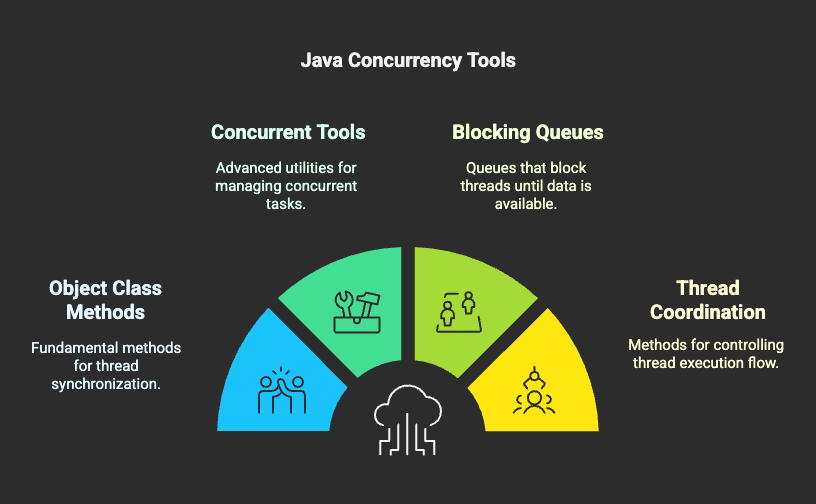️ Coordination: Making Threads Work Together, Not Collide
Welcome to Pillar #4 of the Concurrency & Multithreading: The Ultimate Engineer’s Bible series.
🔗 ← Previous: Atomicity • 🔗 → Next: Task Management (coming soon)
🔝 Parent Blog: The Ultimate Concurrency & Multithreading Guide
Concurrency without coordination is chaos.
Imagine an orchestra with no conductor. Each musician plays well, but no one plays together.

That’s your multithreaded application without coordination: beautiful components colliding in dissonance.
Coordination is about orchestrating threads to communicate, synchronize, and wait for each other — not out of necessity, but out of design.
🎯 What is Thread Coordination?
It’s when one thread says:
“Hey, I’m done. You can go now.”
Or,
“Wait here until we all reach this point.”
Coordination solves a fundamental problem:
How do threads know when it’s safe to proceed?
We use signals, barriers, semaphores, latches — the whole toolbox. Let’s go.

🧱 Level 1: Classic Monitor Methods
The very first tools Java gave us, from the Object class itself:
wait(), notify(), notifyAll()
Inside any synchronized block, you can call:
synchronized(lock) {
lock.wait(); // Thread goes into waiting state
lock.notify(); // Wakes up one waiting thread
lock.notifyAll(); // Wakes up all waiting threads
}
Used for low-level coordination. Powerful but error-prone.
Example: Producer-Consumer (Basic Version)
synchronized(queue) {
while(queue.isEmpty()) {
queue.wait();
}
queue.remove();
queue.notify();
}
Producer notify()s when it adds. Consumer wait()s when empty.
🚀 Level 2: java.util.concurrent Tools
These are the modern, safer, and scalable alternatives.
✅ CountDownLatch
Let N threads wait until a count hits zero:
CountDownLatch latch = new CountDownLatch(3);
// In each thread
doWork();
latch.countDown();
// Main thread
latch.await(); // Wait until count reaches 0
Used in test setups, initialization barriers, microservice orchestration.
🔁 CyclicBarrier
Unlike CountDownLatch, this is reusable. All threads wait until everyone arrives.
CyclicBarrier barrier = new CyclicBarrier(3, () -> {
System.out.println("All parties arrived");
});
barrier.await(); // Each thread calls this
Perfect for iterative algorithms, like MapReduce or parallel simulations.
🔐 Semaphore
Classic concurrency control. Allows N threads into a critical section.
Semaphore semaphore = new Semaphore(3);
semaphore.acquire();
try {
// access shared resource
} finally {
semaphore.release();
}
Use this when you want to throttle access — e.g., API rate limits, resource pools.
🔄 Exchanger
For two threads to exchange data directly.
Exchanger<String> exchanger = new Exchanger<>();
String response = exchanger.exchange("Request");
Rare but useful when you want a handshake mechanism.
📆 Phaser
A more flexible CyclicBarrier with phase control.
Used when you don’t know the exact number of threads in advance or want dynamic phase progression.
Phaser phaser = new Phaser(3);
phaser.arriveAndAwaitAdvance(); // Wait for phase
🧱 Blocking Queues: The Producer-Consumer Kings
Forget reinventing the wheel. Use these:
- BlockingQueue
- SynchronousQueue
- DelayQueue
These handle coordination under the hood. No need to call wait() or notify() manually.
Example:
BlockingQueue<String> queue = new ArrayBlockingQueue<>(10);
producerThread -> queue.put("data");
consumerThread -> queue.take();
It will block when full/empty. Clean, robust, production-grade.
🧘 Analogy: The Factory Floor
Imagine a factory with:
- Workers (threads)
- A conveyor belt (queue)
- A supervisor (barrier)
Each worker puts items on the belt. Others take them off.
The supervisor waits for all workers to finish a step before advancing to the next.
That’s coordination.
You could yell across the factory floor (wait/notify), but it’s better to use signals, gates, and indicators (latches/barriers/queues).
😱 Bonus Tools
These are simple, often underestimated:
- join() — Wait for another thread to finish:
thread1.start();
thread1.join(); // Wait for it to finish
- sleep(ms) — Pause execution for a fixed time
- yield() — Hint to scheduler: “Let someone else run”
⚠️ Pitfalls to Avoid
- Don’t call wait() outside synchronized blocks — you’ll get IllegalMonitorStateException.
- Always match wait() with notify() or notifyAll().
- Be careful with missed signals — if you notify before wait, the thread will wait forever.
- Avoid manual coordination if you can use CountDownLatch, Semaphore, or queues.
🧠 Recap: Your Coordination Toolbox
- Low-level: wait(), notify(), notifyAll()
- Blocking coordination: CountDownLatch, CyclicBarrier, Phaser
- Resource control: Semaphore
- Producer/Consumer: BlockingQueue, SynchronousQueue
- Thread utilities: join(), sleep(), yield()
🤔 Let’s Make It Interactive: Your Turn
Now that you’ve mastered thread coordination, think about this:
- Have you ever run into a coordination bug in a real-world project?
- Which coordination tool do you reach for most often — and why?
- Ever replaced wait/notify with a more modern solution like CountDownLatch or Phaser?
- How would you coordinate hundreds of threads doing parallel database writes?
💬 Drop your answers in the comments — I read every one of them.
🙌 Support This Series
If this article helped you, help me back:
👍 Clap if you learned something new
🔁 Share it with your developer circle — knowledge compounds when shared
🗣️ Comment with your own war stories from production
🧭 Series Navigation
- 🔝 Parent Blog: The Ultimate Concurrency & Multithreading Guide
- ⬅️ Previous: Atomicity
- ➡️ Next: Task Management (coming soon)
You’ve now learned to orchestrate threads like a symphony — no missed notes, no chaos.
🕸️ Coordination: Making Threads Work Together, Not Collide was originally published in Javarevisited on Medium, where people are continuing the conversation by highlighting and responding to this story.
This post first appeared on Read More

